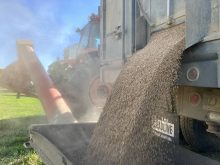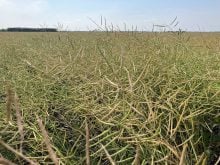Testing has confirmed levels of clubroot capable of producing disease in two soil samples collected from Manitoba canola fields last year, provincial officials say.
“It is significant in that we can no longer consider ourselves free of clubroot in Manitoba,“ said Holly Derksen, a plant pathologist with the Manitoba Agriculture, Food and Rural Initiatives Soils and Crops Branch.
The two samples were among six samples found to contain clubroot DNA that were collected as part of a survey of Manitoba canola fields last summer. Further testing was done under greenhouse conditions using highly susceptible plants.
Read Also

Still hard to predict precise fertilizer payback
Despite decades of advances, international research finds no clear answer for where and when adding nutrient will fail to boost growth.
While the tests are considered positive cases of clubroot, with the spores capable of producing disease, Derksen noted the symptoms of disease were weak and probably wouldn’t show up in a canola field.
“I think it is more of a warning,” she said. It is now more important than ever that canola producers acknowledge that clubroot could be present in their fields and take steps to avoid spreading it around or allowing disease levels to build up to a point where serious infections surface.
MAFRI issued a release March 1 and warned producers attending the CanolaLabs event in Brandon to follow disease-prevention practices such as proper equipment sanitization — especially the removal of soil from farm equipment when moving from field to field.
Derksen said that also goes for any field services farmers have contracted with outside suppliers.
The department is also urging the use of disease-resistant varieties when growing canola, proper crop rotation and good weed management of alternate hosts to decrease the likelihood of a soil-borne disease infesting a field.
“These practices will also help prevent heavier infestations from developing within a field where a disease may already be present at undetected levels,” the department says.
The four out of the six soil samples taken from six unrelated fields that were confirmed through polymerase chain reaction (PCR) analysis to contain clubroot DNA, that did not produce disease symptoms are considered ‘non-symptomatic fields of concern.’
In 2011, two soil samples were identified as non-symptomatic fields of concern, but retesting in spring 2012 resulted in negative PCR results. All fields previously identified will be monitored, with additional soil samples tested in 2013, the department says.
Clubroot, which was first identified in Alberta canola fields in 2003, can cause premature crop ripening and economic losses due to reduced yield in host crops including canola. The spores are soil-borne and long lasting, surviving in the soil for up to 20 years. Once the disease is established in a field, it requires long-term management solutions, MAFRI says.
Since 2009, 566 canola crops have been surveyed and 321 soil samples have been analyzed for clubroot DNA. MAFRI, Agriculture and Agri-Food Canada, and the Canola Council of Canada will continue the Canola Disease Survey in 2013, surveying both in field for canola diseases and collecting soil samples for clubroot DNA analysis.















